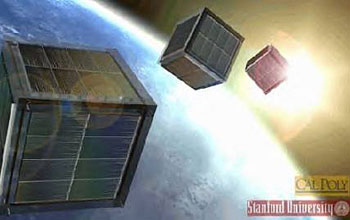All Images
Media Advisory 12-015
Cubesats "Land" at National Science Foundation on Thursday, May 24th
Scientists, engineers, educators from cubesat projects will showcase their projects at NSF headquarters in Arlington, Virginia
This material is available primarily for archival purposes. Telephone numbers or other contact information may be out of date; please see current contact information at media contacts.

NSF-funded cubesats: ultra-small satellites for space weather and atmospheric research.
Credit: CalPoly and Stanford Universities
Download the high-resolution JPG version of the image. (89 KB)
Use your mouse to right-click (Mac users may need to Ctrl-click) the link above and choose the option that will save the file or target to your computer.
Imagine a satellite the size of a half-gallon milk carton. Low-cost satellites just that small have been making history in successes many herald as a "space revolution."
Called cubesats for the roughly four-inch-cubed dimensions of their basic building elements, each one is stacked with modern, smart-phone-like electronics and tiny scientific instruments.
On Thursday, May 24, 2012, NSF hosted an event featuring cubesats. Scientists, engineers and educators showcased their NSF-funded cubesat projects. Scheduled speakers included: Michael Morgan, NSF Division Director for Atmospheric and Geospace Sciences; Roland Coelho, California Polytechnic; James Cutler, University of Michigan; Norman Fitz-Coy, University of Florida; Eloisa de Castro, Princeton Satellite Systems, Inc.
Come join us in space ... aboard a cubesat.
Credit: National Science Foundation

Launch of a rocket on October 28, 2011, that carried the NSF RAX and DICE cubesats.
Credit: Courtesy of spaceflightnow.com
Download the high-resolution JPG version of the image. (185 KB)
Use your mouse to right-click (Mac users may need to Ctrl-click) the link above and choose the option that will save the file or target to your computer.

The 'firefly' cubesat mission studied lightning and gamma rays in thunderstorms.
Credit: NASA
Download the high-resolution JPG version of the image. (1.3 MB)
Use your mouse to right-click (Mac users may need to Ctrl-click) the link above and choose the option that will save the file or target to your computer.

Two completed cubesats at Utah State University in the DICE cubesat project.
Credit: Utah State University
Download the high-resolution JPG version of the image. (163 KB)
Use your mouse to right-click (Mac users may need to Ctrl-click) the link above and choose the option that will save the file or target to your computer.

Researchers at the University of Michigan work on the RAX cubesat project.
Credit: University of Michigan
Download the high-resolution JPG version of the image. (180 KB)
Use your mouse to right-click (Mac users may need to Ctrl-click) the link above and choose the option that will save the file or target to your computer.

The scientific team during final assembly of the RAX cubesat.
Credit: University of Michigan
Download the high-resolution JPG version of the image. (685 KB)
Use your mouse to right-click (Mac users may need to Ctrl-click) the link above and choose the option that will save the file or target to your computer.
